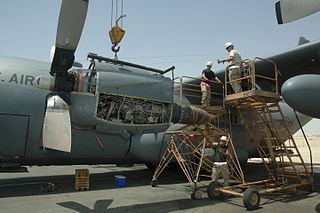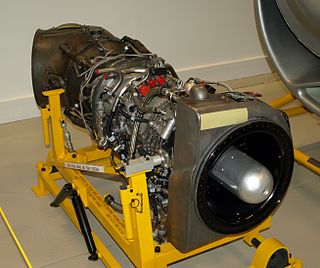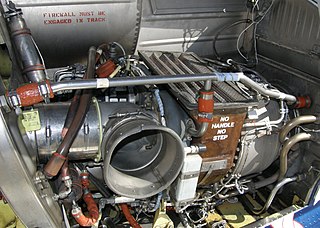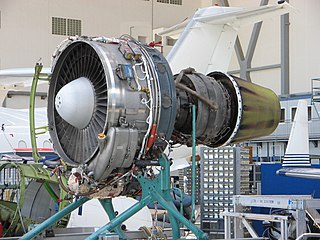
The turbofan or fanjet is a type of airbreathing jet engine that is widely used in aircraft propulsion. The word "turbofan" is a portmanteau of "turbine" and "fan": the turbo portion refers to a gas turbine engine which achieves mechanical energy from combustion, and the fan, a ducted fan that uses the mechanical energy from the gas turbine to force air rearwards. Thus, whereas all the air taken in by a turbojet passes through the combustion chamber and turbines, in a turbofan some of that air bypasses these components. A turbofan thus can be thought of as a turbojet being used to drive a ducted fan, with both of these contributing to the thrust.

The Bristol Proteus was the Bristol Engine Company's first mass-produced gas turbine engine design, a turboprop that delivered just over 4,000 hp (3,000 kW). The Proteus was a reverse-flow gas turbine. Because the second turbine drove no compressor stages, but only the propeller, this engine was classified as a free-turbine. It powered the Bristol Britannia airliner, small naval patrol craft, hovercraft and electrical generating sets. It was also used to power a land-speed record car, the Bluebird-Proteus CN7. After the merger of Bristol with Armstrong Siddeley the engine became the Bristol Siddeley Proteus, and later the Rolls-Royce Proteus. The Proteus was to have been superseded by the Bristol Orion which would have given a Britannia a 75% increase in power for cruising faster.

The Pratt & Whitney PW2000, also known by the military designation F117 and initially referred to as the JT10D, is a series of high-bypass turbofan aircraft engines with a thrust range from 37,000 to 43,000 lbf. Built by Pratt & Whitney, they were designed for the Boeing 757. As a 757 powerplant, these engines compete with the Rolls-Royce RB211.

The Rolls-Royce T406 is a turboshaft engine that powers the Bell Boeing V-22 Osprey tiltrotor. The engine delivers 6,000 shp (4,470 kW).

The Pratt & Whitney J57 is an axial-flow turbojet engine developed by Pratt & Whitney in the early 1950s. The J57 was the first 10,000 lbf (45 kN) thrust class engine in the United States. The J57/JT3C was developed into the J52 turbojet, the J75/JT4A turbojet, the JT3D/TF33 turbofan, and the XT57 turboprop. The J57 and JT3C saw extensive use on fighter jets, jetliners, and bombers for many decades.

The Armstrong Siddeley Mamba was a British turboprop engine produced by Armstrong Siddeley in the late 1940s and 1950s, producing around 1,500 effective horsepower (1,100 kW).

The Rolls-Royce AE 3007 is a turbofan engine produced by Rolls-Royce North America, sharing a common core with the Rolls-Royce T406 and AE 2100, and an original development of the Allison Engine Company.

The Allison T56 is an American single-shaft, modular design military turboprop with a 14-stage axial flow compressor driven by a four-stage turbine. It was originally developed by the Allison Engine Company for the Lockheed C-130 Hercules transport entering production in 1954. It has been a Rolls-Royce product since 1995 when Allison was acquired by Rolls-Royce. The commercial version is designated 501-D. Over 18,000 engines have been produced since 1954, logging over 200 million flying hours.

The Bristol Orion aero engine was a two-shaft turboprop intended for use in later marks of the Bristol Britannia and the Canadair CL-44. Although the engine was built and underwent a development program, the BE.25 Orion project was cancelled in 1958 by the British Ministry of Supply in favour of the Rolls-Royce Tyne. In addition, interest in turboprop-powered aircraft was beginning to wane, because of the successful introduction of the Boeing 707 and Douglas DC-8 jetliners into airline service.

The Rolls-Royce Gnome is a British turboshaft engine originally developed by the de Havilland Engine Company as a licence-built General Electric T58, an American mid-1950s design. The Gnome came to Rolls-Royce after their takeover of Bristol Siddeley in 1968, Bristol having absorbed de Havilland Engines Limited in 1961.

The Lycoming T53, is a turboshaft engine used on helicopters and fixed-wing aircraft since the 1950s. It was designed at the Lycoming Turbine Engine Division in Stratford, Connecticut, by a team headed by Anselm Franz, who was the chief designer of the Junkers Jumo 004 during World War II.

The Garrett TFE731 is a family of geared turbofan engines commonly used on business jet aircraft. Garrett AiResearch originally designed and built the engine, which due to mergers was later produced by AlliedSignal and now Honeywell Aerospace.

The General Electric GE38 is a gas turbine developed by GE Aviation for turboprop and turboshaft applications. It powers the Sikorsky CH-53K King Stallion as the T408.

The LycomingLTS101 is a turboshaft engine family ranging from 650 to 850 shaft horsepower, used in a number of popular helicopters, and, as the LTP101 turboprop, light aircraft. Both models carry the US military designation T702. The engine was originally designed at the Lycoming Turbine Engine Division in Stratford, Connecticut, but is now produced by Honeywell Aerospace.

The Lycoming ALF 502/LF 507 is a geared turbofan engine produced by Lycoming Engines, AlliedSignal, and then Honeywell Aerospace.

The Honeywell/ITEC F124 is a low-bypass turbofan engine derived from the civilian Honeywell TFE731. The F125 is an afterburning version of the engine. The engine began development in the late 1970s for the Republic of China (Taiwan) Air Force AIDC F-CK Indigenous Defence Fighter (IDF), and it first ran in 1979. The F124/F125 engine has since been proposed for use on other aircraft, such as the T-45 Goshawk and the SEPECAT Jaguar, and currently powers the Aero L-159 Alca and the Alenia Aermacchi M-346. The F124 has a rather unusual design for a two spool gas turbine engine, using both axial and centrifugal compressors in its high-pressure compressor. There are currently only three production variants of the engine, although several more have been proposed throughout its lifespan.
The Honeywell HTS900 is an American turboshaft engine produced by Honeywell Aerospace. A growth version of the LTS101 which it is designed to replace, the HTS900 is in the 1,000 shp (745 kW) class.

The Allison T38 was an early turboprop engine developed by Allison Engine Company during the late 1940s. The T38 became the basis for the very successful family of Allison T56 turboprop engine.

The Improved Turbine Engine Program (ITEP), formerly the Advanced Affordable Turbine Engine (AATE) program, is a United States Army project to develop a General Electric T700 replacement for the UH-60 Black Hawk and AH-64 Apache, improving fuel consumption, power, durability and cost. Honeywell and Pratt & Whitney formed the ATEC joint venture to develop the T900, while GE Aviation builds the T901. The US Army selected the GE T901 as the winner of the program in February 2019.

The Lotarev D-136 is a turboshaft engine from the ZMKB Progress Design Bureau. The engine powers the Mil Mi-26 "Halo" helicopter. Development of the engine had begun in about 1972.. The D-136 first flew on a production Mi-26 helicopter in 1980.



















